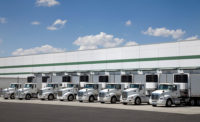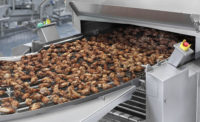Thanks to America’s appetite for animal proteins, the nation’s meat and poultry distribution centers are larger and busier than ever before. With more shipments coming and going, loading dock and freezer/cooler doors are opened more often, resulting in more opportunities to break the cooler-to-trailer cold chain or for pests and outside heat to degrade product. Energy costs are another consideration, as open doors allow expensive cooled air to escape. Fortunately, there are several ways managers can improve their facility’s cold chain, enhancing both food safety and energy efficiency. Here are five suggestions for “buttoning up” your warehouse or distribution center.
Seal loading dock hinge gaps
Start your upgrade process at the loading dock. Next time a trailer is being serviced, stand on the inside of the dock and look for spots where daylight is coming through – chances are you’ll see some. These are areas where expensive conditioned air is leaking out.
Swing-open style trailer doors, when open at the dock, have hinge gaps that expose the equivalent to a 2.5-square-foot hole in the wall if left unsealed. Not only are these enormous energy-loss gaps, they provide a major opportunity for dust and pests to come in. Tight-sealing foam compression dock seals can solve this problem, as can trailer perimeter-sealing dock shelters equipped with hinge-gap sealing hooks on the shelter curtains.
Button up your docks
Some gaps may remain even after a seal or shelter is installed, and additional steps should be taken to completely button up your docks. Small gap-sealing products such as leveler lip corner seals, bumper seals, filler pads and weather seals can address this issue. These are small, individual components that are fitted to effectively seal these often-overlooked areas.
The head pad or head curtain of a dock seal or shelter may be another problem area, as many provide an incomplete seal on certain types of trailers. This is a significant consideration if your dock stations handle a wide variety of trailer types. You can fix this problem by installing a weighted, gravity-based trailer top seal that compresses against short and tall trailers alike, and travels with the trailer throughout its movement.
Don’t forget about the fourth side
Most dock doors are fitted with three-sided dock seals or shelters. However, energy also escapes through a fourth side of the dock, the open pits beneath the dock levelers. This “under-leveler” area is another leading cause of energy loss, since energy wants to travel through the steel deck leveler plate, equalizing the temperature on the inside and outside of the building. A simple two-part under-leveler sealing curtain that fits across the front of the pit will solve this challenge and significantly reduce energy loss from your facility. Facilities adding under-leveler seals may save up to $1,000 per year per dock position in total energy savings, depending on climate.
Consider a drive-through
In some cases, under-leveler seals aren’t needed. Drive-through dock configurations use vertical-storing levelers, which have no pit. Widely considered the “gold standard” for ensuring cold chain integrity and environmental security, they are becoming increasingly common in the meat/poultry industry. With this dock configuration, the trailer’s security seal is cut, and doors are opened inside the loading dock, rather than on the drive approach – thus eliminating any exposure to outside heat, moisture or airborne contaminants.
Vertical levelers also have maintenance advantages. Unlike pit-style levelers, vertical levelers store up and out of the way, making them easier to clean and wash down the floor. Moreover, vertical levelers (when in the stored position) allow the dock door to close directly onto the pit floor for a tight seal.
Save money with high-speed cooler doors
Energy-saving opportunities aren’t just limited to the dock area; they can be found throughout the warehouse. High-speed cooler doors with fast open-and-close times (cycle times) that possess the tight seal of an industrial door can be more important factors in overall energy efficiency than R-value alone.
Doors with low cycle times allow for increased air infiltration and thus higher energy loss. High-speed doors allow people and equipment to move more quickly through door openings, reducing the time for warm air to enter the cooler. The most technically advanced high-speed, roll-up doors can operate at up to 100 inches per second. Some high-speed doors will even automatically snap back onto their tracks after forklift impact, reducing energy loss and downtime associated with fixing a broken or dislodged traditional cooler door.
The bottom line
Facility managers can ensure cold chain integrity, enhance food safety and protect against energy waste by buttoning up their loading dock with tight-sealing dock seals, shelters, and under-leveler seals or by installing a drive-through dock with vertical-storing levelers. Additionally, high-speed doors can protect against cold air loss around freezer and cooler areas. With new food safety guidelines firmly in place, consumer demand at an all-time high and utility costs surging, the time is now to eliminate unnecessary air loss in the loading dock and cooler areas your facility.





Report Abusive Comment